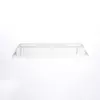Mobile:+86-311-808-126-83
Email:info@ydcastings.com
Connecting Your Sump Pump Discharge Hose for Efficient Water Management Solutions
Understanding Sump Pump Discharge Hose Connectors A Comprehensive Guide
Sump pumps play a crucial role in preventing water damage in many homes, particularly in basements that are prone to flooding. To function effectively, a sump pump must be equipped with a reliable discharge hose that can transport water away from the foundation of the home. At the heart of this system is the sump pump discharge hose connector. This article will explore the various aspects of these connectors, their importance, types, and installation considerations.
What is a Sump Pump Discharge Hose Connector?
A sump pump discharge hose connector is a fitting that connects the discharge hose to the pump itself. The primary purpose of this connector is to ensure a secure and leak-free connection that allows for the efficient transfer of water from the sump pit to the desired drainage location. Without a proper connector, water can leak, resulting in inefficient pumping and potential damage to the surrounding area.
Importance of a Quality Discharge Hose Connector
1. Preventing Backflow A well-designed discharge hose connector can help prevent water from flowing back into the sump pit after it has been pumped out. This is essential for maintaining a dry environment and ensuring the sump pump only operates when necessary.
2. Durability Given the harsh conditions under which sump pumps operate, the materials used in connectors must be robust enough to withstand moisture, pressure, and temperature changes. High-quality connectors are usually made from heavy-duty plastic or metal, which resist wear and tear over time.
3. Ease of Installation A good connector is designed for simple installation, allowing homeowners or contractors to set up the system quickly without needing specialized tools. This is particularly important for DIY enthusiasts who prefer to handle home maintenance tasks on their own.
4. Compatibility Not all sump pumps and discharge hoses are created equal. A quality connector ensures compatibility between various brands and designs, making it easier to replace parts without the need for a complete overhaul of the system.
Types of Sump Pump Discharge Hose Connectors
1. Barbed Connectors These connectors have a series of raised ridges and are typically used for flexible discharge hoses. They grip the hose tightly, preventing leaks. Barbed connectors are easy to install and suitable for varied hose sizes.
sump pump discharge hose connector

2. Threaded Connectors Featuring male and female threads, these connectors are designed for a more secure fit. They are often used in applications requiring a stronger connection, particularly when dealing with higher pressure.
3. Quick-Release Connectors For situations where discharge hoses need to be frequently attached and removed, quick-release connectors are ideal. They allow users to connect and disconnect the hose with minimal effort, simplifying maintenance.
4. Check Valve Connectors These specialized connectors include a check valve that prevents backflow. This device ensures that water does not return to the sump pit when the pump shuts off, keeping the pumping cycle efficient.
Installation Considerations
When installing a sump pump discharge hose connector, there are several factors to keep in mind
1. Access Ensure that the connector is easily accessible for future maintenance or replacement. Installing it in a location that requires moving heavy objects can complicate future work.
2. Proper Sizing Always choose a connector that matches the size of the discharge hose and the pump outlet. An incorrect size can lead to leaks and inefficiencies.
3. Sealant Use For threaded connectors, applying plumber's tape or thread sealant can help prevent leaks, ensuring a watertight connection.
4. Slope and Drainage Ensure that the discharge hose has a slope that leads away from the foundation. This will facilitate proper drainage and prevent water pooling.
Conclusion
Sump pump discharge hose connectors may seem like a small part of the overall system, but they play an essential role in its effectiveness. By preventing backflow, ensuring a secure connection, and accommodating various hose types, these connectors help maintain a dry and safe environment in homes vulnerable to flooding. Understanding the types of connectors and their installation will empower homeowners to make informed choices, keep their sump pump systems running efficiently, and protect their properties from water damage. Whether you're upgrading your existing sump pump or installing a new one, paying attention to these details can make all the difference.
-
Automobile Water Pumps in Vehicle PerformanceNewsMay.21,2025
-
Valve Box Cover Cast Iron: The Backbone of Fluid Control SystemsNewsMay.21,2025
-
Pump Impeller in Fluid DynamicsNewsMay.21,2025
-
Baffled Oil Pans in Racing Cars: How They Improve PerformanceNewsMay.21,2025
-
Compressor Housing Turbo in Pump EngineeringNewsMay.21,2025
-
Why Oil Pan Thickness Matters for Engine SafetyNewsMay.21,2025











